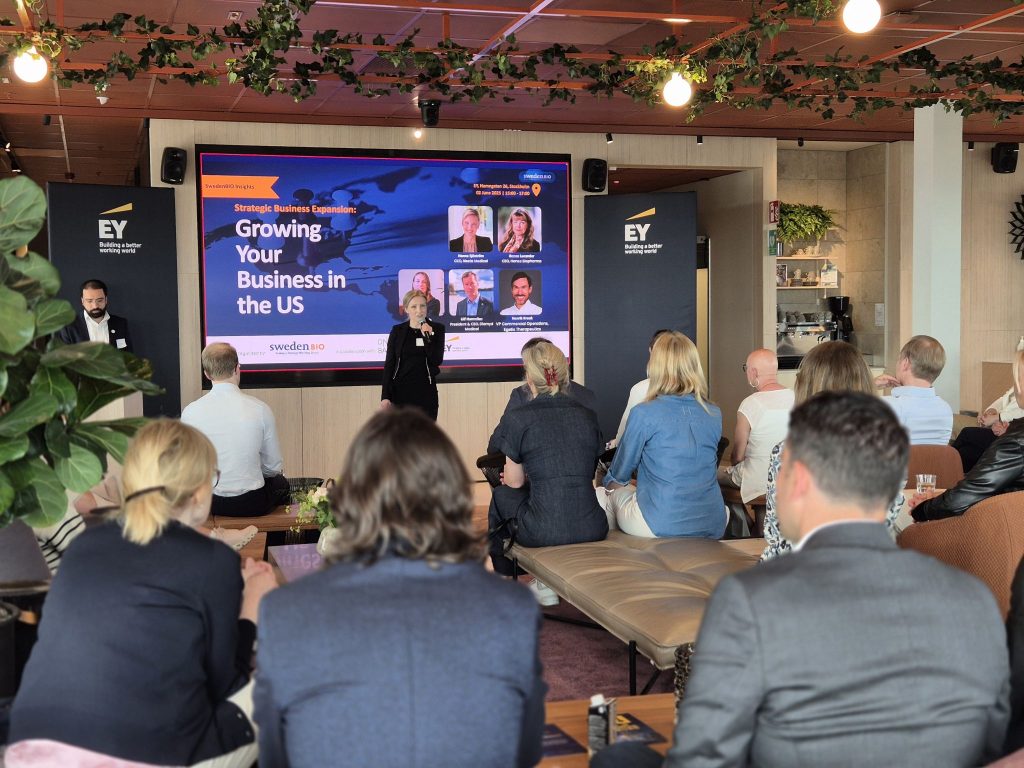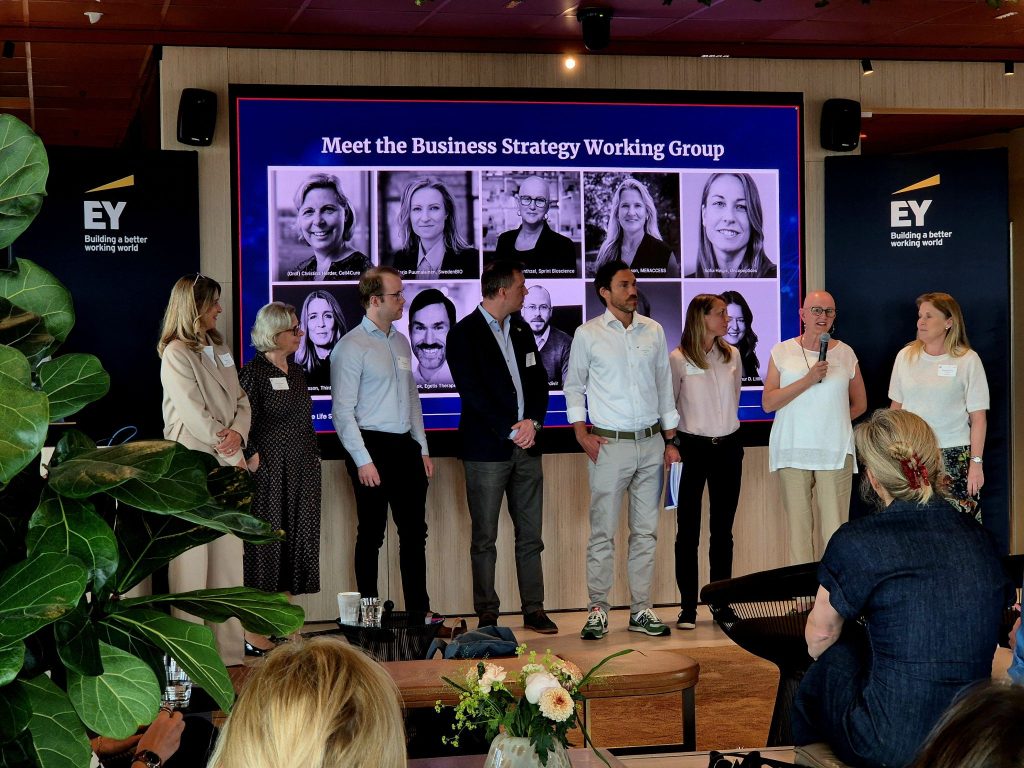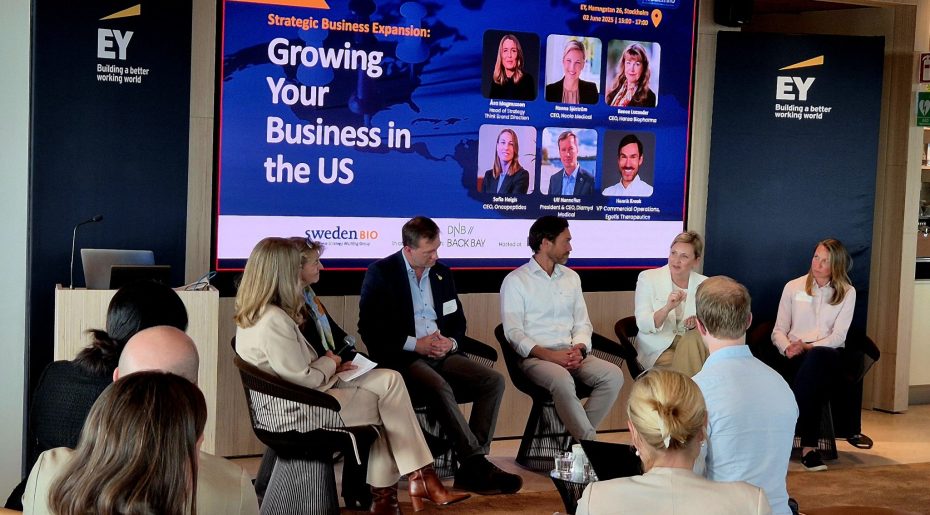There are many compelling reasons for Swedish life science companies to enter the US market. It’s by far the largest market for pharmaceuticals, with 40-50% of global sales revenues – a figure that rises to 70% for orphan drugs. Perhaps more importantly, drug prices are often 2-3 times higher than in Europe, helping companies achieve higher returns on investment.
It’s no wonder that many Swedish companies have entered or are looking to enter this lucrative market, which was reflected in the high attendance at the seminar arranged by SwedenBIO’s working group for business strategy, in collaboration with EY on Monday 2 June 2025.
Define your opportunity early
Henrik Krook, CEO of Egetis Therapeutics, set the stage by explaining the importance of defining your opportunity assessment early on, regardless of your chosen approach.
“An early opportunity assessment can help you navigate product development, quickly decide whether you should conduct clinical trials in the US, assist with discussions with US investors, help you prepare for market access, and provide better understanding of pricing,” he emphasized.

The value of being on the ground
Hanna Sjöström, CEO of Neola Medical, shared her medtech company’s US market experience, exemplifying the need to establish a physical presence to seize opportunities and navigate effectively.
“We are very much a Swedish company built on Swedish research, but our US-based operations are distinctly American, and this has created many opportunities,” she explained. “We have received federal grants and are participating in scale-up programs, which have been excellent ways to access the right networks. Through these connections, we were selected as a Stanford Impact One Company, meaning Stanford believes our innovation has the potential to make a real impact. This has opened doors to many investors and other key relationships and has also facilitated our ongoing contacts with the FDA.”
“If I could share just one learning from our journey, it’s that being on the ground in the US has been invaluable–to develop networks and participate in scale-up programs that connect you with the right people. Finding and connecting with the right people often leads to the right places to conduct clinical studies.”
Know your story inside and out
Renee Lucander, CEO of Hansa Biopharma, with previous US market experience, focused on the need for thorough preparation before tackling the highly competitive and specialized US market.
“You must be crystal clear about your value proposition and story. If it takes you a long time to explain what you’re doing, people will assume you probably don’t understand it well yourself,” she explained, noting the high level of expertise one typically encounters. “Often, the investors and experts connected to them actually know more about the specific market and company than the company presenting to them.”
Her other main point echoed Hanna Sjöström’s experience about the importance of physical presence in the US.
“American investors want to meet the CEO, so consider whether you’re prepared to travel constantly,” she pointed out, underscoring the need for ground presence. “If you’re not in the US, you cannot know what’s happening in the US market. Don’t sit in a room in Stockholm asking each other what you think of the US market, and don’t rely on a Swedish consultant to tell you about it either.”

FDA designations open doors
Ulf Hannelius, President and CEO of Diamyd Medical, focused on his experience dealing with the FDA. He argued that designations like fast-track, breakthrough, and orphan designation are important both for investors and program advancement.
“Once we received fast-track designation last year, it opened the possibility for us to meet with the FDA and discuss the potential for an accelerated approval pathway, which we’re now pursuing,” he explained.
He also provided examples of the FDA’s unique processes and how rejection shouldn’t mean the end of your application.
“We’ve received a ‘no’ from the FDA, which can seem negative and disappointing–you might think they don’t understand what you’re doing. But you simply need to reapply. Often, one application isn’t enough for them to understand everything you’re doing. You need to educate them, re-educate them, and listen to what they’re saying,” he said.
Market access complexity
Sofia Heigis, CEO of Oncopeptides, reflected on her company’s US journey.
“Companies that decide to go to the US independently face enormous pressure because you need to onboard many people for compliance, regulatory, and market access work while cultivating a culture of high engagement, high motivation, and cost control simultaneously,” she said.
“We often think market access is simpler in the US than in Europe–that’s not the case. You don’t have a central payer or HTA assessment like in Europe. You have public payers, private payers in the form of insurance companies, different formulas, various licenses–it’s a complex system you need to understand.”
Her advice is to begin building knowledge early, during phase one, then network and discuss with consultants and when the time is right, invest in the consultants you need.
“You don’t need to hire an American CEO, but you need to stay very close to US leadership. Commercializing in the US costs much more than you can imagine because the US is all about business, and it will cost you money just to breathe–the hourly rates are so high. ‘Cost-effective’ doesn’t mean the same thing as it does in Europe.”
You can watch the seminar here.





